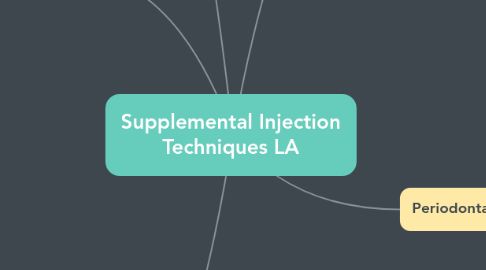
1. Intra Septal Injection
1.1. useful in providing:
1.1.1. Osseous
1.1.2. soft tissue anaesthesia
1.1.3. haemostasis for periodontal curettage
1.1.4. flap surgery
1.2. nerves anesthetised are terminal nerve endings
1.3. areas anesthetised are
1.3.1. Bone
1.3.2. Soft tissue
1.3.3. Root
1.4. needle is held at 45 degree angle to the long axis of the tooth
1.5. 0.2 – 0.4 ml of solution is injected
1.6. Significant resistance to the deposition of solution can be see
1.7. Blanching of mucosa color can be seen
1.8. Repeat injections might be needed as the L.A duration can be short
2. Intra Osseous Injection
2.1. requires the administration of PDL injection
2.2. only can it be performed Sometimes it requires an Interseptal injection & PDL injection prior to this procedure
2.3. This technique is NOT used for deciduous teeth
2.4. requires the deposition of L.A solution in the porous alveolar bone
2.4.1. by forcing the needle through the cortical plate into the cancellous alveolar bone.
2.5. small round bur maybe used to gain access in the bone
3. Intra Pulpal Injection
3.1. useful for obtaining anaesthesia for Endodontic purposes
3.2. Nerve anesthetized
3.2.1. terminal branches at site of injection
3.3. Areas anesthetized
3.3.1. tissues within the pulp chamber
3.4. Indications
3.4.1. Pain control during pulpal extirpatio
3.4.2. Endodontic therapy
3.5. Contraindications
3.5.1. None
3.6. ADV
3.6.1. No anaesthesia of lip & tongue
3.6.2. Minimum volume of anaesthesia is required
3.6.3. Immediate onset of action
3.6.4. Very few post op complications
3.7. DisADV
3.7.1. Traumatic & painful initially
3.7.2. Bitter taste of anaesthetic solution in mouth
3.7.3. Maybe difficult to enter some tooth root canals
3.7.4. need small opening into pulp chamber for optimum effectiveness
3.8. Technique
3.8.1. Use 25 or 27 gauge needle
3.8.2. Wedge the needle firmly into pulp chamber
3.8.3. Deposit the solution without pressure
3.8.3.1. Or Deposit the solution under pressure
3.8.4. 0.2 – 0.3 ml of solution is needed for effective anaesthesia
3.8.5. There is usually resistance to the injection it is normal
3.8.6. Bend needle if needed to get access to the canal
3.8.7. There is a brief period of pain & then it will be OK
4. Information
4.1. used when the other established techniques have achieved partial anaesthesia
4.2. are not the best choice in all situations
4.3. In the Mandible it is always preferred to use a Nerve Block for the purpose of dental extractions as far as possible
5. Periodontal Ligament Injection
5.1. requires a special syringe for the delivery of the drug
5.2. this technique did not become very popular in the past
5.2.1. because of lack of good syringes
5.3. can be used in the Maxilla & also in the mandible
5.3.1. is NOT needed in Maxilla as other techniques can achieve good anaesthesia in the maxilla
5.4. Primary Indications
5.4.1. Need for anaesthesia of 1 or 2 teeth in the mandible in a quadrant
5.4.2. Treatment of isolated teeth in both mandibular quadrants
5.4.3. Treatment in children to avoid lip injury
5.4.4. Cases where nerve block anaesthesia is contra-indicated ( Like in Haemophiliacs )
5.4.5. To help in diagnosis & localization of pain
5.5. Contraindications
5.5.1. Presence of infections in the local area of injection
5.5.2. Primary teeth anaesthesia
5.6. Technique
5.6.1. 27 gauge short needle is used
5.6.2. Area of insertion
5.6.2.1. gingival sulcus along the long axis of the tooth
5.6.3. Bevel of the needle should be on the root
5.6.4. 0.2 ml of solution is deposited over 20 seconds
5.6.5. Fast injections are NOT DONE
